Introduction
The amalgamation of rock music, Minimalism, and world music have given name to a critical movement known as Totalism, a label conceived in the 1980s by musicologist and composer Dr. Kyle Gann after hearing the title being thrown around by musicians hanging out at Rudy's Bar in New York City. As stated by Gann, when he heard the word Totalism for the first time, he knew immediately that a common language was developing within the scene. Since there hadn't been a new musical "-ism" for years, people began to use the term Totalism to refer to this emerging group of composers, all utilizing similar language, echoing each other1.
This label refers to a specific group of composers born mainly in the United States in the 1950s and later based in downtown New York during the 1980s and 1990s.
The New York Times critic Edward Rothstein wrote an article in 1993 about Totalism and stated how the word was floating around the New York downtown scene, in use by talented young composers who wanted to move beyond Minimalism and other styles that had a substantial impact on the new music world since the 1970s2. Like Gann, Rothstein characterized Totalism as both inspired by Minimalism's use of repetition and utilizing rock, pop, and world music instruments. Even though the label is not widely recognized like its Minimalist or Modernist counterparts, it helps to put a name to the musical aesthetics that certain composers of the period had in common. The label has also helped to expose relatively unknown composers who were running in the same circles as the more commonly named composers such as John Luther Adams, Michael Gordon, and Glenn Branca.
Known for her role in the Totalist movement, composer Lois V Vierk’s music is characterized by the exploration of sounds, energy, and their development. Since the 1980s, Vierk has developed principles of what she calls "exponential structure," a mathematical process that builds the energy and structure of a composition3. Some of Vierk's pieces adhere strictly to her principles of exponential structure by gradually increasing or decreasing the beats of the sections in a composition. The composition may be open to changes in duration, making segments longer or shorter depending on the flow and impact of the piece as a whole. These mathematical factors control time, harmonic motion, rhythmic and timbral development, and sound density.
In 1993, the Barbican Centre in London commissioned Vierk to write River Beneath the River for the Kronos Quartet, which was released on Vierk's album of the same title in 2000 under New York City-based label Tzadik Records. Vierk's exponential structure method is evident in this piece, as well as characteristics of Totalism. Both exponential structure and features of Totalism can be found in Vierk's other works, such as Timberline, Red Shift, Cirrus, and Simoom. Even though Vierk doesn’t pay too much attention to the term Totalism, she understands the need and desire to categorize art and music in general, as long as the purpose is to understand it better4. Nevertheless, her music and background have shown that she shares very similar aesthetics to the other composers from this same group and generation.
This paper discusses Vierk's compositional method with particular attention to her connection with Totalism. I will be looking at Totalism's history, Vierk's string quartet piece River Beneath the River, and her compositional method of exponential structure, to learn what factors she shares with the Totalists. I will also show other characteristics of Totalists composers and compare them with Vierk's music to reveal what they have in common and what not. Even though she is listed as part of this group of composers, she also has her unique composing style that is not related to this movement. By closely examining all these aspects, the result of this project will add new knowledge on Totalism and Lois V Vierk.
Vierk’s Biography
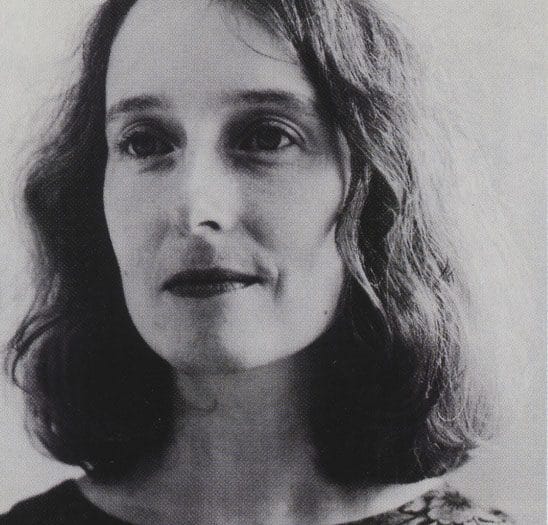
Fig 1.1: Lois V Vierk
American composer Lois V Vierk (1951) was born in Hammond, Indiana and grew up in Lansing, Illinois, and Jenkintown, Pennsylvania. She studied ethnomusicology at the University of California, Los Angeles and graduated in 1974. During her years at UCLA, she first focused her studies on Bugaku (Japanese Court Dance) and later on Gagaku (Japanese Court Music), specifically studying Gagaku ryuteki flute performance. After graduating, she continued studying and working with Gagaku for over ten years with her teacher Mr. Suenobu Togi. Vierk made her living as a pianist for dance classes at the Los Angeles ballet and studied composition privately with Leonard Stein from 1974 to 1976. Mr. Stein encouraged Vierk to go to the California Institute of the Arts to continue her composition studies with Mel Powell and Morton Subotnick.
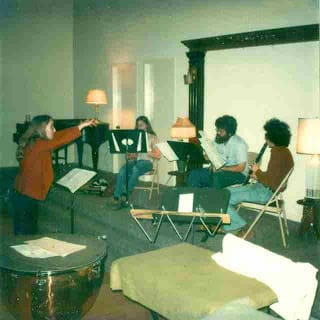
From late 1981 through 1984, Vierk moved to Tokyo to study Gagaku with master musician and lead ryuteki player of the Japanese Emperor’s court, Mr. Sukeyasu Shiba, spending most of her time as a student rather than actively composing. After her time in Tokyo, Vierk moved to New York City in 1984 and connected with the downtown music scene.
Vierk’s compositions have been greatly influenced by her studies of Gagaku music. In an interview held by Ann McCutchan, she mentioned that Gagaku hugely influenced her, regarding the use of multiples of the same instrument, and the glissandi that always remind her of sounds found in nature such as water, wind, and loons. In Gagaku, there are pieces that have flutes or various hichiriki double reeds playing rhythmically free canons5. Vierk states that the appeal for her of using multiples of the same instrument is that the transparency of timbre allows small nuances of dynamics, articulations, and pitch slides to be clearly heard.6
Vierk sees herself as a composer from the generation after the minimalists, both chronologically and artistically. Through the influences of Gagaku music, the minimalist music of Phill Niblock, and her own personal voice, she has created a very strong and distinctive style of composition. One of Vierk's strong trademarks as a composer is how her pieces develop gradually, from a quiet character moving gradually to a busier one. Her pieces may approach a moment where the music suddenly gets dense, which is somewhat of a natural occurrence brought about by Vierk's exponential structure method.
In 1998, Lois V Vierk's health was suddenly compromised by an extreme autoimmune disease called eosinophilia-myalgia syndrome (EMS). After visiting various doctors, she met physician Kim Sing Lo, D.O. in New York City. Unfortunately, there has still been no treatment for this disease, but with osteopathy exercises, Vierk’s health has been improving.
Frank J. Oteri states in his interview with Ms. Vierk that she was on the cusp of something important back in 1998, and her music was starting to get a lot of attention. Not only did Vierk release two critically acclaimed records during her subsequent illness, but she was part of an influential documentary about new music by Michael Blackwood Productions released in 1997. EMS not only wreaked havoc on Vierk’s health and wellness, but also interrupted her enormous strides in her career as a composer, and this cannot be ignored while examining the scope of her output.7
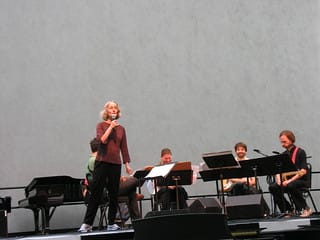
Despite the adversity that Vierk has been through, her music has been performed at major venues worldwide, including Carnegie Hall, Lincoln Center, Bang On A Can festivals, Darmstadt Summer Course, Radio Bremen, the Huddersfield Festival, the Schleswig-Holstein Festival, the Edmonton New Music Festival (Canada), the Suntory Festival (Tokyo) and the Adelaide Festival (Australia).
Vierk’s association with the Totalism school
Totalism is defined by composer and musicologist Kyle Gann as, “writing music that appeals to audiences on a sensuous and visceral level, and yet which still contains enough complexity and intricate musical devices to attract the more sophisticated aficionado.”8 Totalism can be characterized as having a steady, articulated beat, often flavored by rock music or world music. According to Gann, this movement acquired its name in the early ’90s when it was evident that individual composers in downtown New York shared similar compositional aesthetics. Even though the invention of the term is not recognized worldwide, Gann states that the similarities of that body of music are a historical fact. Although some of these composers don’t see themselves as part of the movement the same way as Debussy did with the label Impressionism, which he hated, or Glass with Minimalism, Gann says, “-ism is a club everyone talks about, and no one belongs to.” Adding categorization helps garner and maintain the attention of audiences, helping music to survive. In addition, establishing a label can communicate information about what an audience might expect to hear, and the culture and history associated with that music.9
In an article about Totalism published in 1993 in The New York Times, Edward Rothstein suggests that the name for this style of music should be Polymorphism instead of Totalism because of how smoothly the piece’s character develops and its immense diversity. Rothstein describes the music with words such as “experimental,” “playful,” and “aggressive.” He argues that Totalism identifies with the tenets of the avant-garde in opposition to the mainstream, an attitude that leans toward the radical left and a sense of self-importance. According to Rothstein, it is music that may have a feeling of anxiety and ambiguity. His article offers an interesting perspective of Totalism from another source in addition to Gann, and this shows a broader move among prominent writers also keeping an eye on this developing style of music in the downtown New York scene, verifying that it is indeed a style.10 Rothstein does not mention Vierk in his article, but the way he describes Totalism characterizes Vierk’s music.
Totalism has been influenced by Minimalism regarding pitch material as a starting point but utilizes more complex rhythmic ideas. The Totalists wanted music with regular beats, allowing for focal points on tempo contrasts. Also, there is a significant influence from rock music, which these composers encountered from childhood, and non-Western music taught in universities as part of the curriculum. Gann explains that "the Totalist composers are those who admired minimalism's ability to communicate to large audiences, yet also admired serialism's ability to produce more information on further hearings and welcome the rhythmic complexity of non-Western music."11
Common characteristics in the work of Totalist composers include the incorporation of heavy and repeated beats with complicated polyrhythms and unexpected changes of tempo. Another common feature is the use of a nine against eight polyrhythm, found in many compositions of this group. To achieve this, there has to be an inaudible quarter-note beat occurring, while one musician plays dotted eighth notes, and the other plays triplet quarters. Some composers that are considered part of this movement in addition to Lois V Vierk include Mikel Rouse, Michael Gordon, Larry Polansky, Glenn Branca, David First, Peter Garland, John Luther Adams, Bernadette Speach, Nick Didkovsky, Phil Kline, Allison Cameron, Rhys Chatham, Kyle Gann, Arthur Jarvinen, Ben Neill, and Evan Ziporyn. It is important to note that some of these composers' music is associated with post-Minimalism as well, as Totalism and post-Minimalism are often considered parallel practices. Both of these artistic movements are influenced by, and strive to develop upon, the aesthetic of Minimalism.
Gann, however, seeks a broader understanding of Vierk’s music which goes beyond the simple label of Totalism in his chapter on Vierk in his book American Music in the Twentieth Century. He argues that Vierk’s earliest works were composed for a variety of instruments and were influenced by composer and video artist, Phill Niblock, who was a significant influence on many composers and performers in New York during this period. In all of Vierk’s works, one can hear the expressive glissandi of Gagaku, the effect of different lines played by multiples of the same instrument, and the sustained linearity of Niblock and Alvin Lucier. A useful example of Vierk’s influences can be heard in Luciers' sound installation Music on a Long Thin Wire, which is a classic example of his studies of sound and the acoustic effects of natural developments.12
The first piece that Vierk recorded was Go Guitars (1981) for five electric guitars. As Gann explains, the piece explores microtonal pitch waverings and long, ascending/descending fast glissandi. Additionally, Vierk’s extensive use of electric guitar is another representation of her rock and pop influences. Another early piece Gann discusses in this context is Vierk’s piece Timberline (1991), written for flute, clarinet, bassoon, viola, double bass/electric bass, synthesizer, and percussion. This was Vierk’s first piece displaying her sense of tremendous textual crescendo in an ensemble of different instruments. Timberline is a perfect example of the original chamber textures produced by young composers in the ‘90s.13
The influence of Minimalism, rock music, and Gagaku, is evident in River Beneath the River. As will be shown later in the paper, the use of pitches and intervals is mostly focused on the repetition of perfect fourths, fifths, and major thirds. This offers a focal point to the rhythmic complexities and gradual development that is present throughout the piece. In addition, the influence of Gagaku music comes through the use of glissandi, which is one of the focal sounds in this piece. Unlike Vierk’s other work which features multiples of the same instrument, the use of canons is an essential element in the piece, which are also commonly found in Gagaku music. There is an energy and rhythmic feel throughout River Beneath the River reminiscent of rock music indicated by the high octane energy and 32nd note tremolos with constant beats.
River Beneath the River Analysis
Vierk’s composition River Beneath the River for string quartet was composed in 1993 and revised between 1996 and 1999. In an interview I had with Vierk, she stated that part of the revision was to tighten up the piece compositionally by removing extraneous material and allowing the music to clearly flow and reach its high point.14 Vierk wants the performer to play her music as accurately as possible, and sometimes she finds that notation needs to be edited so any performer anywhere may understand exactly what she intended.15 Her editing sometimes has to do with dynamic balances so that a given part may be strongly depicted by the players, while others are less in the foreground, especially when dealing with techniques and sounds that are not frequently occurring in a given piece.
One of River Beneath the River’s vital characteristics is the presence of 32nd note tremolos combined with generous use of glissandi. Vierk specifies in the score for the performers to not use any vibrato for the duration of the entire piece, and that all instruments should be equally distributed in volume except in one specific section. As stated in the score, “the term ‘river beneath the river’ comes from the Spanish expression ‘Rio Abajo Rio’, which refers to the innermost soul, the most profound expression of a human.” The piece is one long movement that can be divided into three smaller segments. The first section occurs from the beginning of the piece through the end of letter C (measures 1 to 97). The second section starts at letter D (measure 98) and culminates at the end of letter E (measure 148). Finally, the third section begins at letter F (measure 141), concluding the piece at the end of letter Q (measure 320).
There is a constant development of pitch, rhythmic, and gestural materials in this piece. The opening section begins with the first violin and cello playing a perfect 5th, on a 32nd note tremolo, and moves through glissandi down a minor third in bars 2 and 3. A shorter version of this same gesture is repeated in measures 3 and 4 by the second violin and viola as a response. In bar 4, the cello plays a glissando going up from D to A. This motive from measures 1 through 4 is repeated and elongated throughout the first section of the piece.
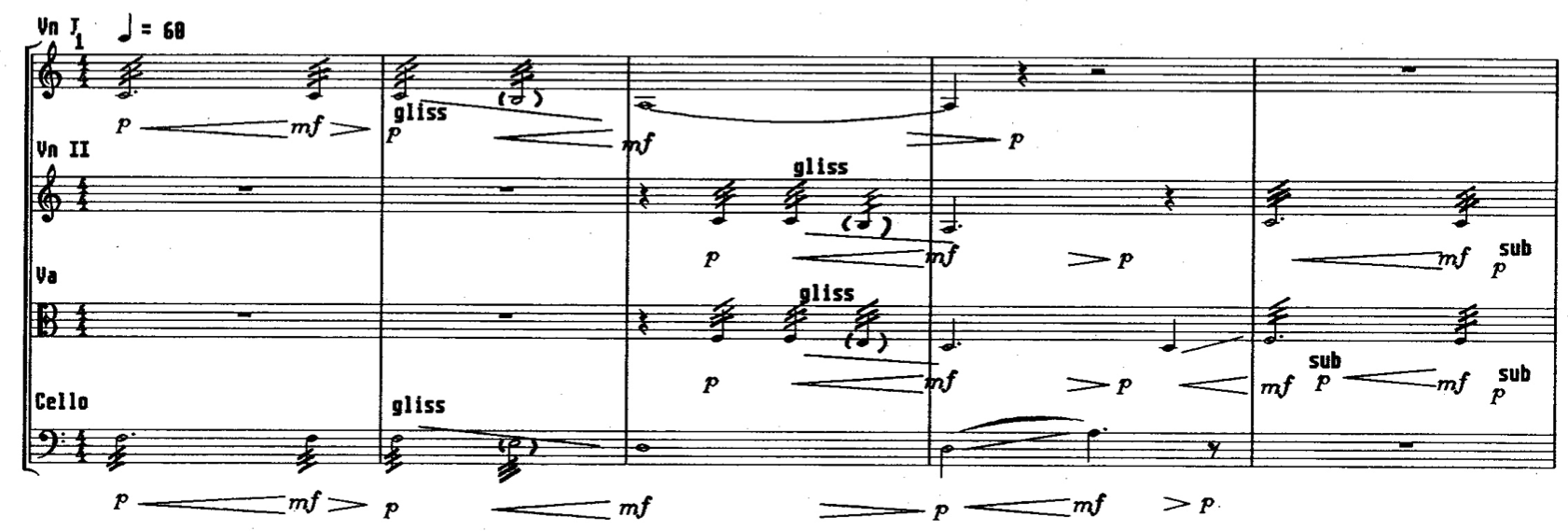
In measure 13, pitches Ab and Eb played by the violin and cello are introduced as a dotted quarter note and an eighth note. Ultimately, the eighth note figure will evolve and become very important throughout the piece.
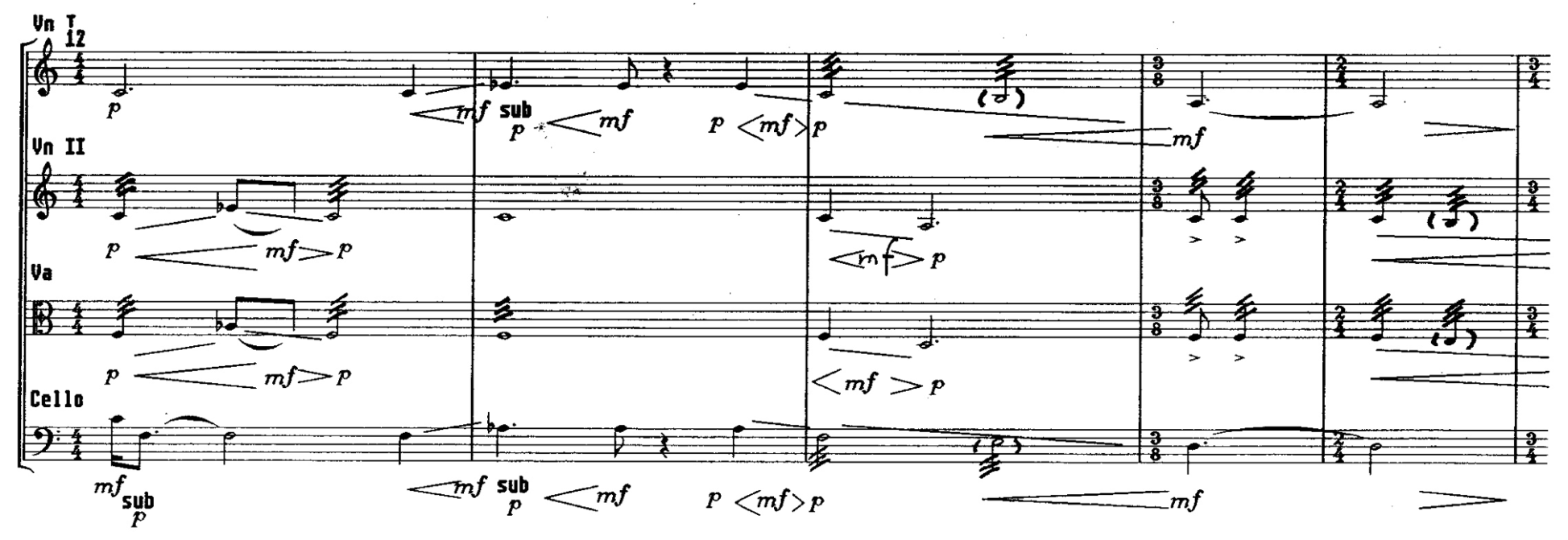
At the end of the opening part from measures 29 to 32, violin one and cello play glissandi first down and then up, while violin two and viola play the same gesture, but in contrary motion. This contrary motion repeats throughout the piece. The letter A section starts with an interval of a 5th between violin one and cello and between violin two and viola. The parallel fifths descending by minor thirds continue featuring prominently throughout the rest of letters A, B, and C.
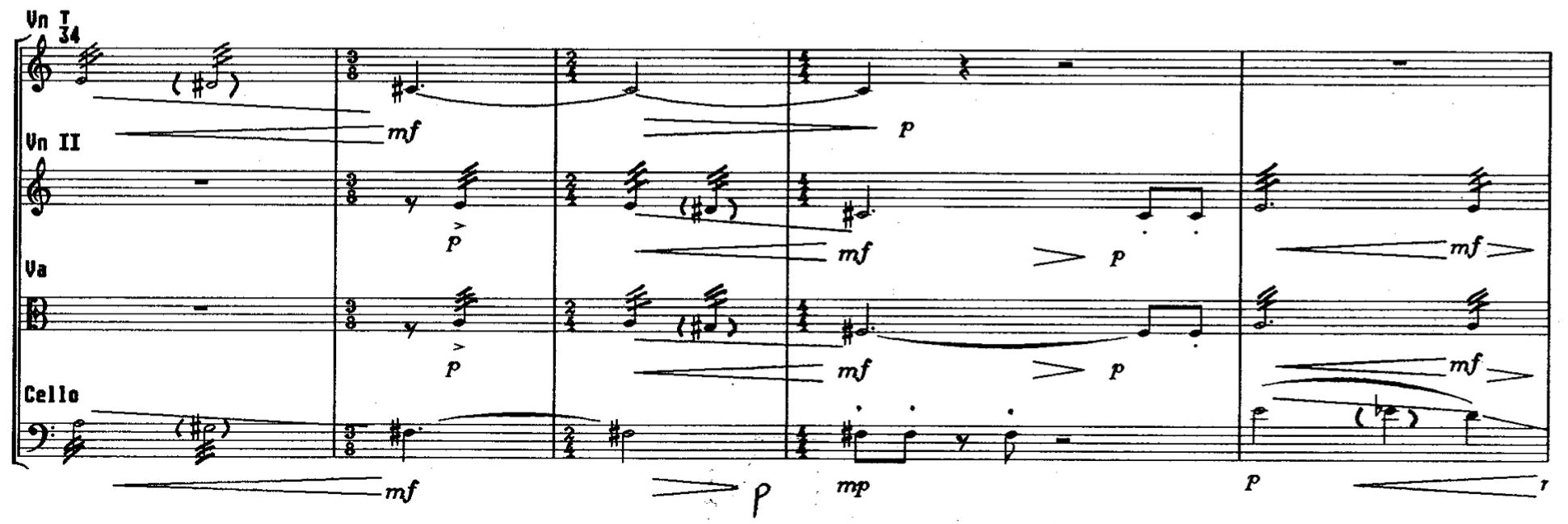
In measures 60 to 63, a canonic descending perfect 4th glissandi occurs at the end of the phrase. The rhythmic interval among the various instruments is a quarter note and this is the introduction of a gentler and more lyrical feeling. This idea is also carried out through letter B and letter C. The descending perfect 4th eventually becomes a descending octave at the end of the phrase. This is heard in measures 78 to 82, leading the music into letter C.
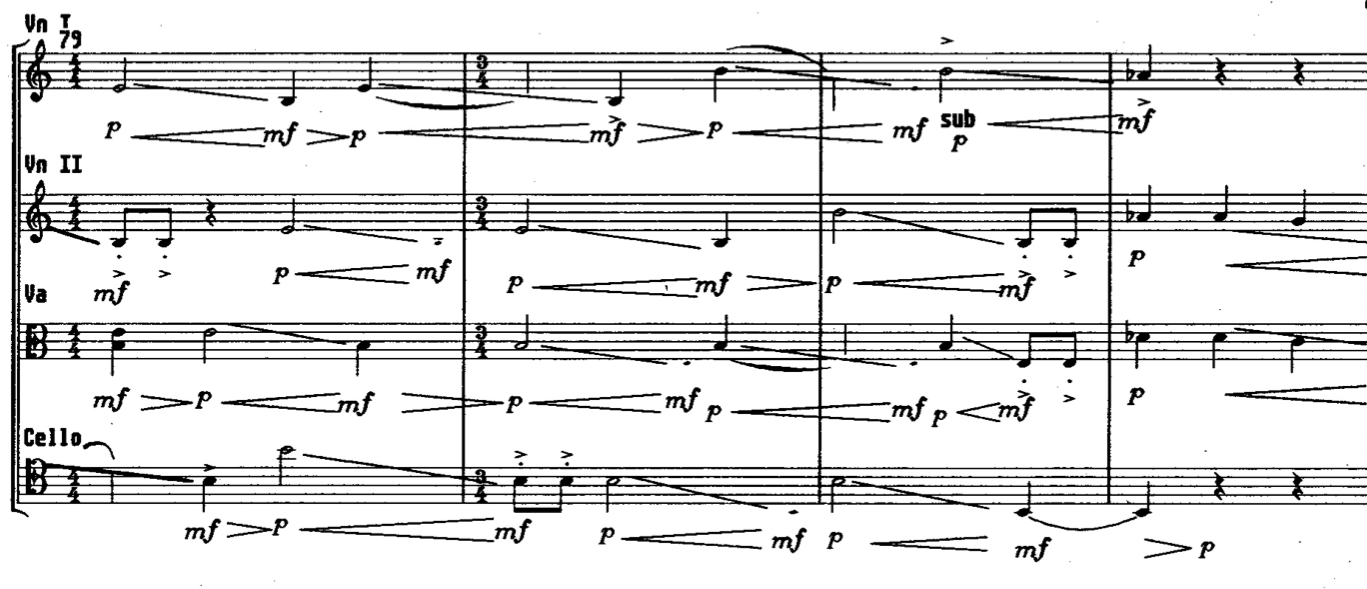
At letter D (measure 98), the piece is more expressive and is intervallically dictated by major thirds. In the first measure, violin two and cello are playing G and B, glissing down. The composer notes to “Bring out violin one and violin two” from measures 99 to 133, meaning that they must be higher in volume. There are no tremolos in this section; the tremolo effect gradually disappeared in the measures leading up to this section. Then letter E gets busier, as the eighth note idea develops to three and four consecutive eighth notes as seen in measures 128, 131, 135, and so on until the end of the section. In measure 126, there are only eighth notes played by violin one, violin two, and cello, and there are also quarter notes and dotted quarter notes. In measure 128, the viola and cello have more consecutive eighth notes, and by measure 131, the cello is playing only eighth notes followed by the viola also playing eighth notes in bar 132.
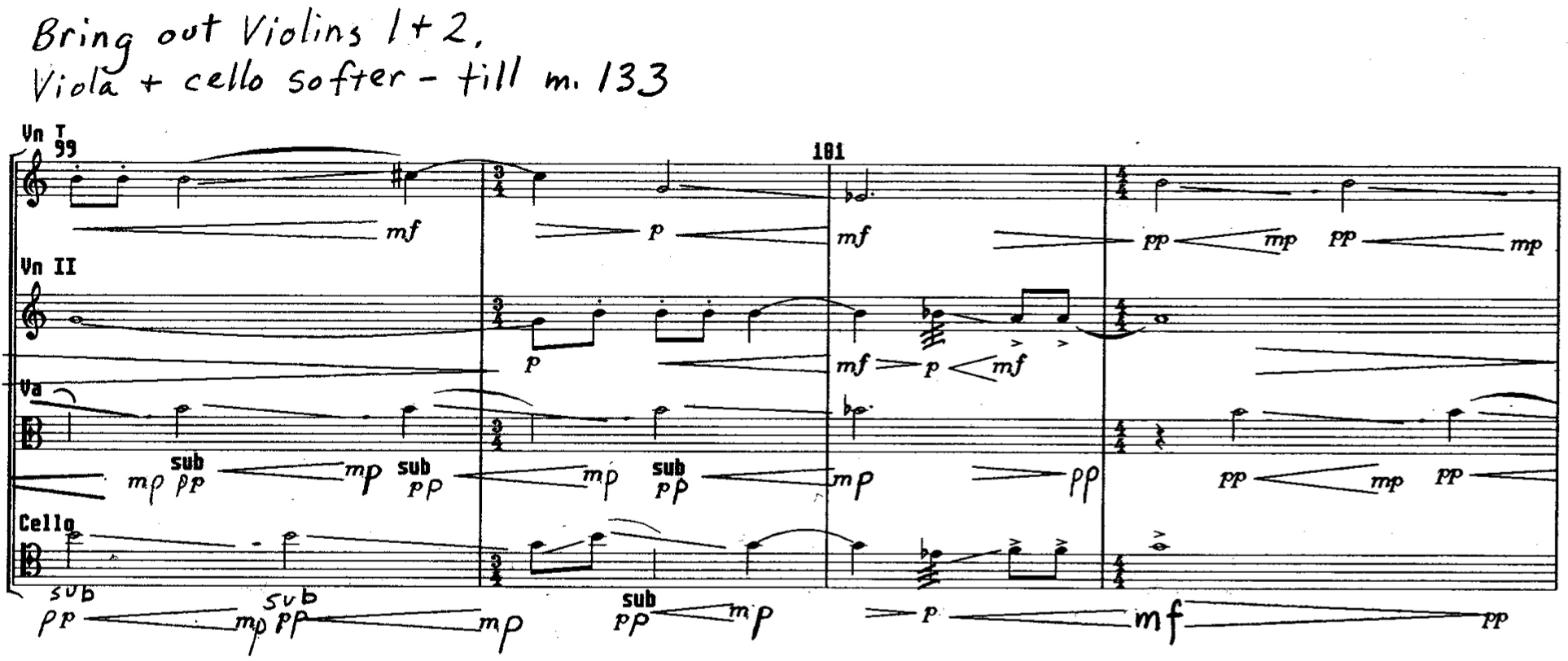
The third and last section of the piece starts at letter F in measure 141. This section is energetic, and from this point onward, the intensity continues to rise until the end of the piece. Each letter of this section generally becomes shorter, starting with 54 beats at letter F, 45 in G, 41 in K, 35 in L, 29 in M, and 24 in P. The interval of a fourth stands out from letter F through L, and after that, letter M is dictated by the interval of a perfect fifth, and letter P returns to perfect fourths. The consecutive eighth notes start to repeat more and evolve slowly into sixteen notes, which begin at measure 175, where the rhythmic value is introduced by violin one, playing four consecutive sixteenth notes. In bar 177, the cello plays four consecutive sixteenth notes. In bar 178, violin two plays four consecutive sixteenth notes, and the rhythmic figures evolve slowly until more instruments play consecutive sixteenth notes, such as in measure 209 and later in measure 237.
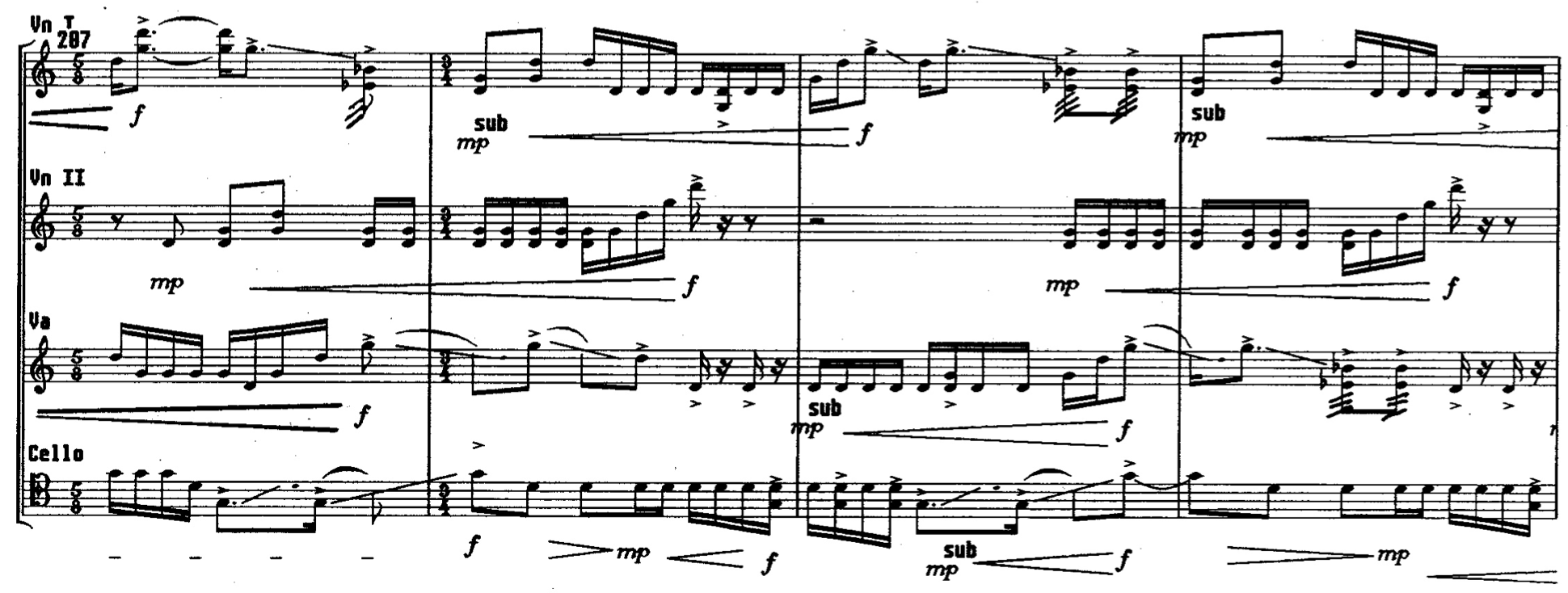
Throughout the piece, there is a large-scale development in dynamics, with every letter growing in intensity and volume. Harmonic motion speeds up, as is evident at letter O and P. The tremolo effect returns at letter Q but is not used as much as in the beginning. The tremolo effects are short and placed in more specific locations. The individual and cumulative instrument's ranges continue expanding through each letter, with higher pitches played by the violins and the viola, and lower pitches played by the cello. There is an accumulation of accents and letter Q emerges as the climax of the piece with high volume, more accents, very high and low ranges in pitch, and the return of glissandi tremolos, producing the most high-intensity section.16 17 At letter Q, measure 294, violin one is playing B on the fifth ledger line above the staff, the highest pitch in the piece. Simultaneously, the cello is playing E on the second ledger line below the staff, the lowest pitch in the piece. Each note has an accent marking, which makes this section the most dramatic. The piece ends with precisely the same pitches that letter Q started with, with all instruments playing E and B, all in different registers, emphasizing fifths.
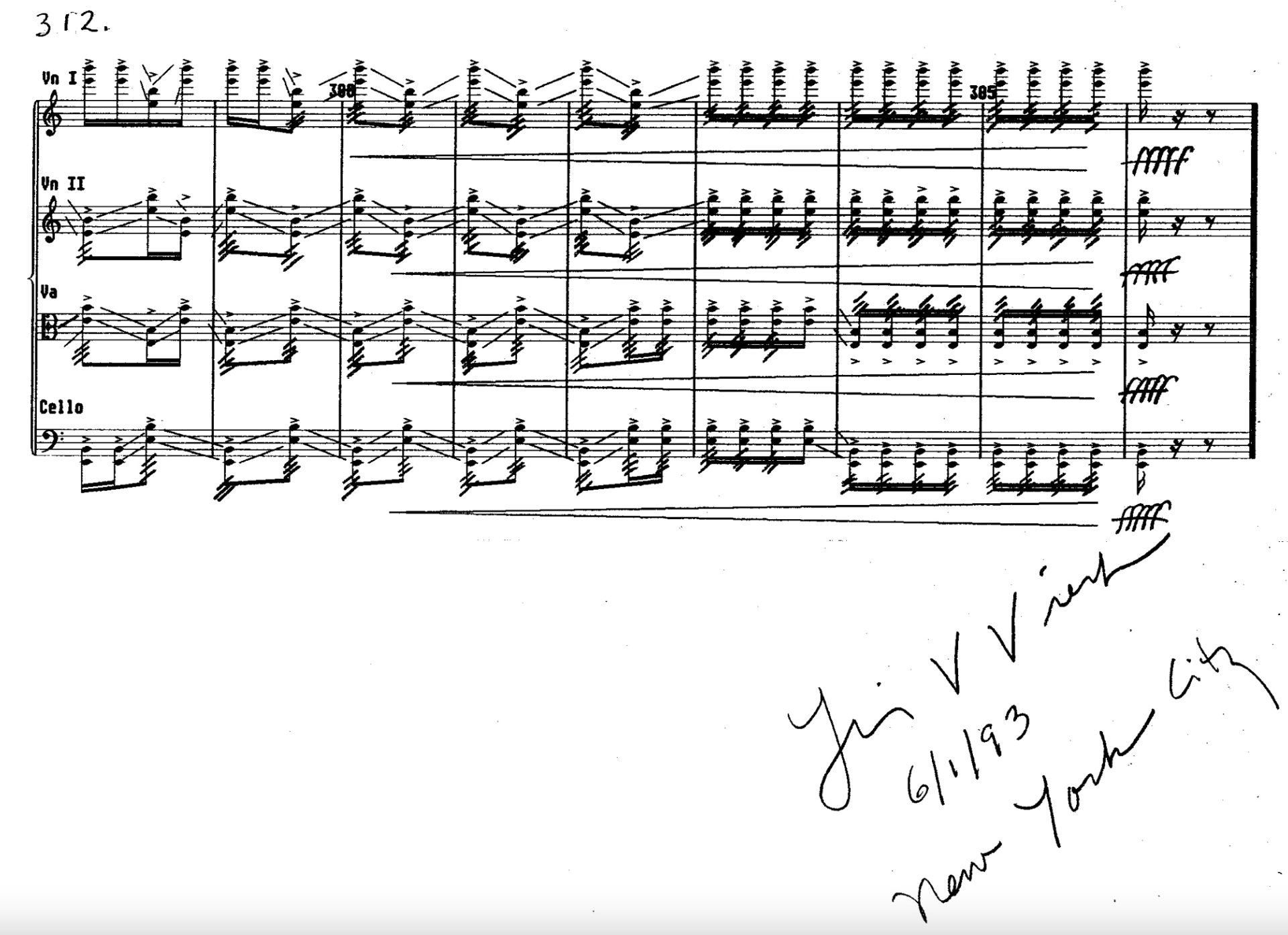
Compositional Process/Exponential Structure
The sound itself is an essential element and a compositional starting point for Lois V Vierk. Her process typically starts with assembling the performers to begin reading the first sketches, which includes requests that they improvise sounds. She asks several questions to understand their instrument’s different aspects, such as dynamics, register, lyricism, and speed. Sometimes, she asks them to change what is written to make a part sound more exciting, fun, and energetic. After this, Vierk goes back to making more sketches, avoiding censoring what appears, writing anything and everything that comes to mind, a stream of consciousness -like approach.18 19
Later in the compositional process, Vierk looks at what she has written thus far, conceptualizing and feeling out the energy and flow of those sounds, and then decides which sounds to build into a piece.20 In this way, her creative process is greatly sound-oriented. During this part of Vierk’s compositional practice, she will often have already selected the final sound in a piece or sound at a pivotal point. Then, she will start thinking about the piece as a whole, considering an order that works better in structure, form, and duration. Throughout this course, Vierk reaches the final version of a piece. During an interview I had with Vierk in 2020, she explains her compositional process:
“I am concerned with the sounds as well as with making sense because I find that combination rewarding. I like working with the development of one sound into the next. I plan how this development will happen and make sketches of the development, keeping in mind my plan for the timing of sections. I've developed principles of what I call Exponential Structure. Some pieces have adhered fairly strictly to these principles, but I've always been ready to change the timing of sections in this Exponential Structure, making sections longer or shorter as needed for the flow and the impact of the piece as a whole. Gradually, with both sound materials and formal considerations making sense, the piece comes into existence. I'm never afraid to change anything at all, as needed for the flow and energy of the piece as a whole. After the first performance, or even many performances later, it's common for me to keep making changes.”21
Since the 1980s, Vierk has been crafting her principles of sound organization using exponential structure. In an interview with writer Ann McCutchan, Vierk explains how all sensory phenomena in the body are measured mathematically in exponential terms rather than linear terms. The one exception is the length of a line: if someone looks at two lines, that person can judge if one is, say, twice as long as the other. The line is perceived as twice as long and it actually is twice as long. However in other situations it is not so simple, as confirmed by many scientific experiments. For example, sensory stimuli (such as loudness of sound, brightness of light, amount of pain, etc) that are perceived by the human body as “twice as much” or “three times as much” or “four times as much” as a reference stimulus, do not have two, three, or four times the amount of energy as the reference. It is actually some number squared, cubed, and to the 4th power compared to the reference. Explorations of different sensory stimuli have produced a different exponential equation, a different curve, for each one.22
Vierk thought it would be interesting to apply such ideas to time and rates of development and change of musical material. In some of her pieces, the amount of time in sections of the work is ever-decreasing, (which is equivalent to taking the above example and working backwards towards smaller values rather than towards larger values. When she initially started applying these kinds of mathematical processes in her compositions, she would follow it in a straightforward way. For example, if the first section of a piece is based on a particular pitch, it would be x number of seconds long. Then the second section would be .9 times x; the third section would .9 squared (or .81) times x, the next would be .9 cubed (or .73) times x, the next .9 to the fourth power (or .66) and so on. In River Beneath the River, each section has a pitch center assigned to it and as the sections of the piece are getting shorter, the pitch centers are changing and unfolding more quickly.
In the more prominent framework of the piece, Vierk develops rhythmic changes, such as altering a slow rhythm to a quicker rhythm. For example, in the first section of a piece she may write half notes, and by the last section, they would evolve into sixteenth notes. Vierk could also superimpose another organization for changes with timbres and with another equation. She could make several structures for different aspects of the music within the global structure. This process is dependent on the emotional sense of the piece.23
Vierk has applied her method of exponential structure within different aspects of her piece River Beneath the River in a freer way than found in her earlier compositions. Unfortunately, all documents with the original equations are lost. Since she was also open to changing and modifying the numbers to suit the musical materials and the piece as a whole, it might not be perfectly clear for theorists to understand how exactly she applied the concept. Nevertheless, elements such as dynamics, rhythm, speed, timbres, and beats are clearly mathematically manipulated. For example, Vierk first develops a plan for pitch centers all over the entire piece, assigning a number of seconds or beats to each pitch center. These notes can be seen in all of her sketches.

Another example of exponential structure in River Beneath the River is shown in how Vierk develops the notes throughout the piece. For instance, the beginning of the piece is predominated by dotted half notes, half notes, and quarter notes. Those notes start evolving into eighth notes and dotted eighth notes during the first section of the piece. Then, during the second section, the eighth notes start becoming more prominent until they take over completely. Later at letter H, the sixteenth notes are introduced slowly until they take over the piece entirely from letter L throughout the end.
Vierk has also applied exponential structure to the beats of each section, as can be seen in her sketches, although some of the original numbers have been manipulated for the sake of the piece as a whole. For example, the opening section has 96 beats, then letter B has 58 beats, letter K has 49 beats, letter L has 39 beats, and letter P has 24 beats. As a result, the piece seems to get faster and faster but not in the tempo, just in how the musical material is moving past the listener’s ear. Consequently, there is an increase in energy and gradual development of musical materials starting calmly, getting more exciting and having more densely packed information in a shorter amount of time. Vierk has stated that she has been interested in ever-decreasing time segments, as can be seen in these examples.24
“You can see at a glance how the time segments continue decreasing. This sets up a musical structure. Time is ever-shortening. Depending on the materials and how they are developed, the structure can be rushing to a climactic conclusion. This is what I desired in the pieces where I used Exponential Structure.”
In sum, the effect that this method gives to the piece is powerful, and even if the listener doesn't know how the composition was made or has any knowledge about exponential growth, the slow, gradual development is very recognizable and it is a trademark of Vierk’s compositional style.
Conclusion
Lois V Vierk has developed her voice as a composer through her mentors' teachings and personal growth. Her work draws from Gagaku, Minimalism, rock music, and many other elements. In addition, Vierk frequently features her technique of exponential structure, creating her own personal and unique sound world. Nevertheless, it is crucial to consider that the label Totalism, just like any other art movement, not only categorizes similar trends that artists utilize during a specific moment in history, but also gives context to what people are listening to. According to Vierk, she respects the need and desire to categorize art and music, as long as it intends to understand the art of music itself better.25
Each composer labeled as “Totalist” has a unique style, like any composer from any movement. Still, they all share similar aesthetics and tendencies in their music, in part because of their musical and academic backgrounds. We must also consider that these composers came from the same generation and took part in the downtown New York music scene. If Totalism's label had gained more popularity, more Totalist composers would have been firmly cemented into the canon of music history.
Vierk’s piece River Beneath the River is an excellent example of a Totalist piece because of the influences from Gagaku, rock music, and Minimalism.. Also, the time period is significant, as River Beneath the River was composed during the 1990s when the New York City downtown scene was populated with composers pulling from similar influences, and musicians were apt to throw around the term Totalism. Hopefully, over time, Vierk’s musical output will continue to draw increased interest from writers and researchers. In addition, the investigation of this underrated and complex movement that we call Totalism may follow.
Gabriel Vicéns
Gabriel Vicéns is a critically acclaimed guitarist, composer, and educator from Puerto Rico based in New York City. He has published multiple albums under his name and as a co-leader with the free improvisation group No Base Trio. His latest album, Mural (2024), is a collection of chamber works composed for various ensemble configurations and performed by some of New York's finest classical musicians. He earned a Doctor of Musical Arts from Stony Brook University in 2022, and in 2023 he received the New Jazz Works grant from Chamber Music America. His work has been written about and reviewed in many national and international publications. He currently works with students at his NYC home studio and has an active performance schedule.

Citations
- Kyle Gann, Music Downtown: Writings from the Village Voice (University of California Press, 2006), 127-29.
- Edward Rothstein, “Minimalism Pumped Up To the Max,” The New York Times, 1993.
- Ann McCutchan, The Muse That Sings: Composers Speak About the Creative Process (New York: Oxford University Press, 1999), 151-160.
- Gabriel Vicéns, “Interview with Lois V Vierk.” 2020.
- McCutchan, The Muse That Sings: Composers Speak About the Creative Process, 151-160.
- Dan Joseph. Interview with Lois V Vierk, March, 1999.
- Frank J. Oteri, “Lois V Vierk: “Slideways. Newmusicbox”, 2008.
- Kyle Gann, American Music in the Twentieth Century (New York: Schirmer Books, 1997), 355.
- Gann, Music Downtown: Writings from the Village Voice, 127-29.
- Rothstein, “Minimalism Pumped Up To the Max”.
- Gann, American Music in the Twentieth Century, 363-65.
- Alvin Lucier, “Music on a Long Thin Wire”, Lovely Music, 1993. CD.
- Gann, American Music in the Twentieth Century, 363-65.
- Vicéns, “Interview with Lois V Vierk.” 2020.
- Vicéns, “Interview with Lois V Vierk.” 2020.
- Lois V Vierk, “River Beneath the River.” Frog Peak Music, 1993. Score
- Lois V Vierk, “River Beneath the River.” Tzadik Records, 1993. CD
- McCutchan, The Muse That Sings: Composers Speak About the Creative Process, 151-160.
- Vicéns, “Interview with Lois V Vierk.” 2020.
- McCutchan, The Muse That Sings: Composers Speak About the Creative Process, 151-160.
- Vicéns, “Interview with Lois V Vierk.” 2020.
- McCutchan, The Muse That Sings: Composers Speak About the Creative Process, 151-160.
- McCutchan, The Muse That Sings: Composers Speak About the Creative Process, 151-160.
- Vicéns, “Interview with Lois V Vierk.” 2020.
- Vicéns, “Interview with Lois V Vierk.” 2020.
Bibliography
Bernard, Jonathan W. “Minimalism, Postminimalism, and the Resurgence of Tonality in Recent American Music.” American Music, vol. 21, no. 1, 2003, pp. 112–133.
Bernewitz, Robert Von. “Lois V Vierk - An Interview With The Composer Who Utilizes Her Extensive Knowledge Of The Ancient Art Form Of Gagaku In Her Music. Every Slide Serves To Move The Melody Forward. Every Slide Has A Meaning, Besides Being Beautiful.” Musicguy247, 2017.
Blackwood, Michael. “New York Composers: Searching for a New Music.” Michael Blackwood Productions. 1997. DVD
Carl, Robert. “Three Points on the Spectrum: The Music of Louis Karchin, Lois V Vierk, and Paul Dresher.” Contemporary Music Review 10, no. 1 (1994): 11–31.
Gann, Kyle. “Minimal Music, Maximal Impact Minimalism Gets Complex: Totalism, Newmusicbox.” Web.Archive.Org, 2001.
—. American Music in the Twentieth Century. New York: Schirmer Books, 1997.
—. Music Downtown : Writings from the Village Voice. Berkeley: University of California Press, 2006.
—. Vierk, Lois V. Grove Music Online. 2001. Oxford University Press. Date of access 3 May. 2020.
—. “Rules Of The Word Game.” Artsjournal.com, 2006.
—. "Totalism As A New Rhythmic Paradigm". Artsjournal.com, 2006.
Krasnow, David. “Lois V Vierk's River Beneath The River.” BOMB Magazine. Bombmagazine.org, 2000.
Matthews, Harry. “Interview With Lois V Vierk.” 2019.
McCutchan, Ann. The Muse That Sings : Composers Speak About the Creative Process . New York: Oxford University Press, 1999.
Oteri, Frank J. “Lois V Vierk: Slideways.” Newmusicbox, 2008.
Rodney Lister. Tempo 60, no. 238 (2006): 53-59. Accessed May 6, 2021.
Rothstein, Edward. “Minimalism Pumped Up To the Max.” The New York Times, (July 1993): 23.
Sfetcu, Nicolae. The Music Sound. Nicolae Sfetcu, 2014.
Stanton, Jason. “Thirty Years of Postminimalism: Elements and Growth.” MM Project Report., California State University, Long Beach, 2010.
Tischhauser, Katherine J. “A Survey of the use of Extended Techniques and their Notations in Twentieth Century String Quartets Written since 1933 by American Composers with a Selected Annotated Bibliography and Discography.” DM Diss., The Florida State University, 2002.
Tommasini, Anthony. “They Want You to Listen, Not read.” (The Arts/Cultural Desk)(MUSIC REVIEW)(Concert Review). The New York Times, The New York Times Company, 1 June 2013.
Turner, Grady T. “Art, Film, Theater, Music, and New writing.(Editor’s Choice)(Critical Essay).” Bomb, no. 73, New Art Publications, Sept. 2000.
Vicéns, Gabriel. “Interview with Lois V Vierk.” 2020.
Vierk, Lois V. “River Beneath the River.” Frog Peak Music, 1993. Score
—. “River Beneath the River.” Tzadik Records, 2000. CD
—. “Words Fail Me.” New World Records, 2015. CD
—. “Simoom.” XI Records, 1990. CD
—. “Lois V Vierk, composer. 2011.”
—. “As A Non-Guitarist, How Have You Approached Composing Music For The Guitar? Lois V Vierk.” Newmusicbox, 2004.
—. “What Is Your Favorite Tuning System? Why? Lois V Vierk, Composer.” Newmusicbox, 2000.
—. “Speaking of Music at the Exploratorium in 1987 : Lois V Vierk : Free Borrow & Streaming.” Internet Archive, 23 Apr. 1987.
—. Wolfe, Julia. “Embracing the Clash.” PhD Diss., Princeton University, 2012. Zorn, John. “Arcana : Musicians on Music.” Granary Books, 2000.


